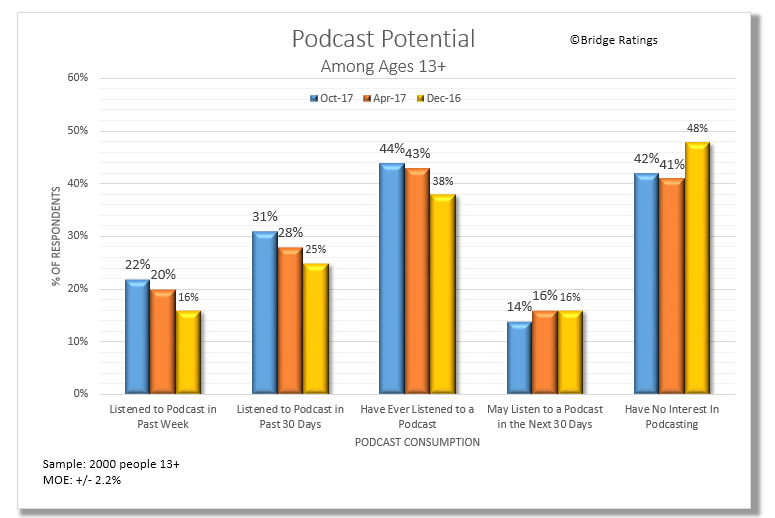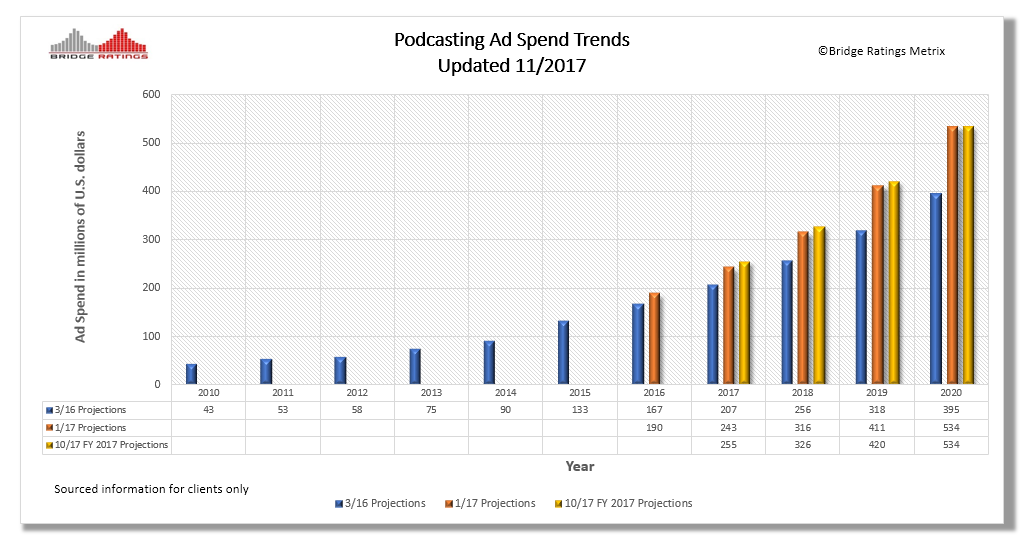2017: Podcasting's Breakthrough Year
An analysis by Bridge Ratings President Dave Van Dyke
Check off another year of amazing growth for digital media now that 2017 is near its end.
On-demand video and audio continued significant growth and the music business saw record-breaking revenues primarily at the hand of streaming's increasing acceptance by all age groups.
In the nuggets of data released in Bridge Ratings' report "Podcast Report 2018 " our analysts' projections of a huge breakout year for podcasting were confirmed with revenues and audience growth spiking. New tech was introduced to the public this year (example: Castbox) that will allow more consumers to easily search and sten to podcasts.
Technology this year began to reduce the three most problematic issues which have been limiting podcasting's potential:
1. Ease of Use
2. Simple but powerful search capabilities
3. Consumption metrics for revenue generation
Technology like, Otto Radio, automatically curates audio streams of podcasts and audio news based on a listener’s interests. This allows each audio broadcast/podcast to be “relevant, compelling and entertaining". This alone could simplify podcast search to boost listener engagement.
Bridge Ratings utilizes this type of technology with our on-going focus groups to gauge a) podcast consumption patterns among current podcast listeners and b) if this new tech would reduce the friction that has heretofore limited podcasting as a reach medium.
We found that the search capability of this technology alone increased interest in listening to more podcasts or trying them for the first time.
“Voice controlled audio search is beginning to establish an invigorated user growth factor and will further enhance time-spent with podcasts in 2018.”
Podcasting Potential - An Update
Bridge Ratings conducted in person, telephone and on-line questionnaires to determine the most current attitudes about podcast listening now through the visor of the new technology which was described in detail to panelists.
What we have learned is that 2017 has shown even more growth over our original estimates published in January 2017 with a significant increase in the number of people who said that they are listening to one or more podcasts weekly.
The average time spent with each listening "session" has increased by 5 minutes and the number of podcasts consumed each week has grown from 7 to 8. This number has been impacted by a new category of podcast listeners - podFASTERS - who are using podcast players with the ability to increase playback speed. This flexibility allows this new class of podcast listeners to consumer a significant number of audio each month. Without the podFASTERS in our panel, the average number of podcasts consumed each week would have decreased from 7 to 6.
Our updated Podcasting data shows larger growth than last year.
Earlier this year the number of respondents with NO interest in podcasting had dropped to 41%. However, in this new released, the number has inched up to 42%.
Those who have listened to a podcast in the past 7 days increased to 22% from our April finding
31% listened to a podcast in the past 30 days, up from 28%.
Those who have ever listened to a podcast increased to 44% this year.
And, as podcasting begins to become more pervasive. the number of respondents who "may listen to a podcast in the next 30 days actually decreased this time to 14%.
These are eye-popping numbers.'
Technology like the Amazon Echo are presenting new ways to consume podcasts and is reducing some friction to ease of use. There is no need to sign up or register to listen to podcasts on this platform. Amazon has partnered with internet radio provider TuneIn which includes over six million podcasts. If you have an Amazon Echo all you need to say is "Alexa, play the program This American Life".
Reasons for not listening to Podcasts
Digging deeper into the mindset of the average audio consumer, we found some of the reasons people don't listen to podcasts has changed very little.
A. While technology has moved forward, 42% of the sample that have no interest in podcasting or haven't yet listened are still unsure as to how to find podcasts, where to look for them and how to listen to them.
B. 30% just don't have the patience or the time to seek out audio programming they believe is available elsewhere.
C. Of the 44% who have ever listened to a podcast, a quarter (25.4%) found the podcasts they did listen to be either boring, too long and rambling or the hosts were not very good communicators.
Clearly, there are very high quality podcasts of varying lengths and topics that are compelling and hosted by professional-sounding people who have figured out that getting people to stay with their podcast requires thought, planning and an ability to present a focused discussion on the topic at hand. There is an art to verbal storytelling.
Reasons to Like Podcasting
1. Find your niche
Whether for personal or business, there's a podcast on any topic imagined. Sharing interests with other people provides a social element to podcasting. Podcasts allow users to dive deeper into hobbies, explore new ones, and creates cultural awareness.
2. You can still multi-task
Instead of plugging in and listening to music, podcasts are excellent entertainment for the commute or leisure activities. Video requires both eyes and ears, but podcasts deliver incredibly audio interesting content. Whether driving to work, taking the train, or sitting on a bus, listening to a podcast passes the time and doesn’t distract you.
3. They’re free
Most podcasts are free, and perfectly legal to download. There are hours upon hours of free content. For entertainment, for business, for anything, fans of podcasting have access to a huge catalogue of series and episodes to enjoy for absolutely free.
4. Learn new things
Any hobby, any passion, and any interest will have a podcast. Whether fans of James Bond or crowd-sourced children’s stories that have been made into audio plays, there's something for everyone. Many podcasters that explore skills, hobbies, and other interests are typically experts or very knowledgable, and listening to episodes is one of the best ways to learn more about whatever it is you are into.
5. Find a new community
We also updated the data related to why podcast consumers like to listen to podcasts.
By nature, each podcast typically has its own community consisting of listeners of the show. They continue the conversation on social media, organize meetups, and explore the topic together to learn from each other. Podcast communities share a passion with each other, and are excited to find other people who like the same things. Some of the well-known podcasts plan massive events and live-tapings too, bringing together fans and listeners from different parts of the world in one place.
We also updated the data related to why podcast consumers like to listen to podcasts.
Podcasting Advertising Spend
Based on increasing interest by the public, reduced friction to search and access podcasts and interviews with 25 national and regional advertising agencies Bridge Ratings projects 27% ad spend growth in the podcasting universe for 2017 and 29% in 2018 with total 2017 spend nearing $255 million. As the chart below shows, this $255 million figure is an increase over our January estimates for 2017.
The chart below reflects podcasting ad spend growth from 2010 to 2020. The blue bars represent our original forecasts. Projections for 2017 and beyond were originally determined in January of 2017 and again in October 20017 based on similar sources of growth and ad agency interest.
Generational Power Boost
Click on image to enlarge. This chart breaks out generational interest in podcasting.
The latest Bridge Ratings data also reveals that all generations will expand podcast consumption this year, and Millennials are an important part of the mix - especially from the ad agency perspective. This most-sought-after life group will be more present as podcast listeners for advertisers. Why are Millennials – as well as folks in the younger 12-17 demographic – listening to podcasts, which are primarily talk programming?
- It’s all about the device. The younger you are, the more attached you are to your device. If the content is available on your device, it’s worth your attention.
- On demand content is the everything. No matter what they’re consuming, younger demos are consuming it on their terms: what they want, when they want it.
- Shared content is important. Not only do Millennials like to share, they like to like what others share. Listen, and share with your friends.
- Non-fiction and reality content is a thing with Millennials.
“Much of the growth in podcasting we are projecting for this year rests on the shoulders of the content creators because ultimately a flood of audio consumers...will be short-lived if the presentation, production and focus of the content cannot hold listener interest.”
Final Thoughts
Based on our Las Vegas focus groups and most recent field study, 2017 holds great promise as a breakout year for podcasting. This may be the year when a confluence of technology, advertising and consumer interest boost momentum for the platform which offers content for just about every taste and interest.
However, much of the growth we are projecting still rests on the shoulders of the content creators because ultimately a flood of more audio consumers to the podcasting platform will be short-lived if the presentation, production and focus of the content cannot hold listener interest. And while our studies indicate that the more "professional"-sounding the podcast the greater chance for additive subscription behavior increasing audience reach and interest.
Broadcast radio and television will provide further interest in podcasting this year as talent from these platforms have the ability to widely promote their podcasts to built-in fan bases.
We'll field an updated study mid-year 2017 to gauge how well these projections are pacing.
Methodology: Data utilized in this analysis was derived from interviews fielded by Bridge Ratings between 11/01/16-12/16/16 and 01/02/17-01/07/2017 from a sample of 2750 persons ages 12 and over through a national random digital dialing process in addition to on-line surveys. 5 focus groups with a combined total sample of 54 persons 18+ were conducted during the week of 1/03/17-1/07/17 to determine opinions and reaction to new technologies. R
Revenue projections are based on a combination of podcast consumption projections determined through the aforementioned field studies and telephone and on-line interviews and questionnaires with 25 regional and national advertising agencies.


